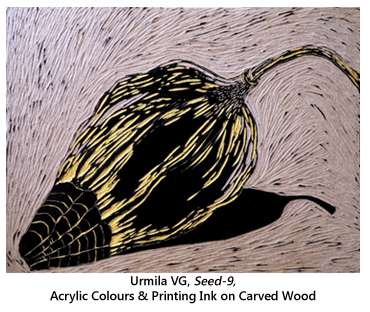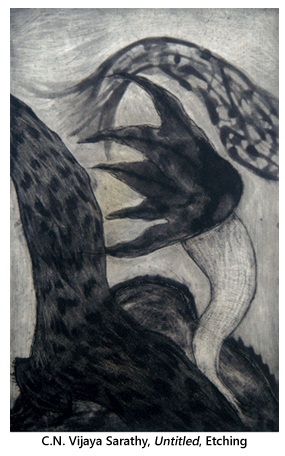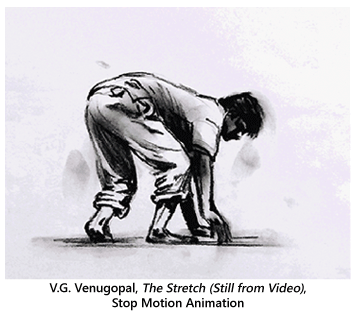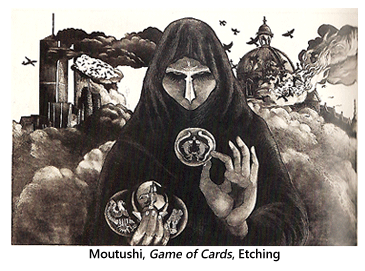- Publisher's Note
- Editorial
- Sixteen printmakers talk about their work
- The Imprinted Body
- A Chai with Vijay Bagodi
- The Wood Engravings of Haren Das
- A Physical Perception of Matter
- Feminine Worlds
- A Rich Theater of Visuality
- A Medley of Tradition
- Decontextualizing Reality
- Printmaking and/as the New Media
- Conversations with Woodcut
- Persistence of Anomaly
- Sakti Burman - In Paris with Love
- Lalu Prasad Shaw: The Journey Man
- Future Calculus
- A Note on Prints, Reproductions and Editions
- A Basic Glossary of Print Media
- The Art of Dissent: Ming Loyalist Art
- Vishnu: Hinduism's Blue-Skinned Savior at the Brooklyn Museum of Art
- Twelfth edition of Toronto International Art Fair
- Vintage Photographs of the Maharajas
- Göteborg International Biennial
- A Museum, a Retrospect & a Centenary for K.K. Hebbar:
- Recent and Retrospective: Showcase of Shuvaprasanna's Work
- "I Don't Paint To Live, I Live To Paint": Willem de Kooning
- Salvador Dali Retrospective: I am Delirious, Therefore I am
- To Be Just and To Be Fair
- Census of Senses: Investigating/Re-Producing Senses?
- Between Worlds: The Chittaprosad Retrospective
- Awesomely Artistic
- Random Strokes
- Counter Forces in The Printmaking Arena and how to Counter them
- Shift in focus in the Indian Art Market
- What Happened and What's Forthcoming
- Art Bengaluru
- Mumbai Art Sighting
- Musings from Chennai
- Art Events Kolkata
- Previews
- In the News
ART news & views
Printmaking and/as the New Media
Volume: 4 Issue No: 21 Month: 10 Year: 2011
Feature
The demand for an art-historiographical Shift
by H.A. Anil Kumar
Printmaking is a term that is busy claiming more and more autonomy from, say, other specializations such as painting within the history of visual forms of representation. In this regard, apart from local anecdotes, the story of art history in India or elsewhere doesn't seem to vary much. The media of printmaking is more specific than that of painting, because, it is staunchly believed that the qualitative depth of a print actually lies upon its surface. Painting refuses to endorse this idea because, ideally speaking, the 'surface' of a painting is defined by the 'interventions' that its physical surface is subject to. [1] Arguably, a surface that is considered a virtue in and of itself as against a surface that has art historically yielded itself to in-depth studies marks the confrontation between printmaking and painterliness. Lithography, etching, viscosity, woodcut (not wood-engraving), and serigraphy are those that are, in themselves, specified imaginations as 'printmaking', and in general usage owing to the impact of colonial-oriented art pedagogy and its lingering contemporary avatars in the Indian context.
'interventions' that its physical surface is subject to. [1] Arguably, a surface that is considered a virtue in and of itself as against a surface that has art historically yielded itself to in-depth studies marks the confrontation between printmaking and painterliness. Lithography, etching, viscosity, woodcut (not wood-engraving), and serigraphy are those that are, in themselves, specified imaginations as 'printmaking', and in general usage owing to the impact of colonial-oriented art pedagogy and its lingering contemporary avatars in the Indian context.
In other words, printmaking is fundamentally a term which is proposed more and more from within the practice of art teaching. Teaching has construed printmaking while two dimensional representations in general (that consider printmaking as only a part) have administered the outline of art pedagogy. In other words, printmaking - no matter how varied the images emerging through a particular graphic media are - is thought of as a tiny art-historical unit that always demands the presence of its counterfeit (say, painterliness), for its own presence to be felt.
Today, the sociology of printmaking [2] seems to have met the same fate as that of still life as a genre - both have accepted the fact that they are anorexic (Norman Bryson's phrase for a condition wherein the marginalized form accepts its position, without contestation, as being marginal). Many printmakers have migrated to more lucrative forms of expression, abandoning possible discourse within printmaking. However, some other artists (Archana Hande, Paula Sengupta, K. K. Mohammad and the like) have dissolved the content and frame of a print beyond any convention of recognition and bifurcation (as 'frame around an image'). Thus the interactive ability between the convention called printmaking and new media becomes a fact which is to be theoretically acknowledged. [3]
K. K. Mohammad and the like) have dissolved the content and frame of a print beyond any convention of recognition and bifurcation (as 'frame around an image'). Thus the interactive ability between the convention called printmaking and new media becomes a fact which is to be theoretically acknowledged. [3]
The post-Walter Benjaminian era divided printmaking into manual reproduction, technological reproduction and digital simulations. Consider video art. The way it is displayed is an integral part of 'being a video work'. It is looped, to be seen again and again, and this is analogous to two (or more) similar reproductions of the same image. In other words, two similar graphic prints and a re-view of the video are one and the same in essence. The difference lies in only viewing a physical replica and an emotional reliving of similar experience, respectively. What is space to a graphic print is time in the case of video. Graphic artists, or artists interested in graphical reproducibility, acknowledged this aspect before art history did. This is a unique case wherein the digital world converted space into time through the aid of one of the essences of printmaking - its ability to replicate ('simulate' in this case), without bifurcating the original from a copy and vice versa.
The ability for manual reproduction, so much problematised by printmaking, instead of finding a solution in the digitally simulated world, instead problematises the history of printmaking itself…for certain epistemological gains. Between manual and technological reproduction a certain 'reversal' of the universe occurs, rather literally. The presence or the absence of a mirror alone can differentiate reproduction from a technological premise to the manual ones. The left and right (not only in the viewed aspect but also politically) of images are subject to a paradoxical situation. 'We can never get a reproduction of what is seen as something drawn on a litho stone' is a statement that can be pitched against yet another statement that 'any representation, no matter however faithful to the lived world, is its replica' in order to produce at least two varieties of reproductions: reproducing the world as-it-is and doubly reproducing it by getting a reversed version of what was already manually reproduced from the actual world. This argument doesn't bring in any sense of the hierarchy between the painterly, manual representations like watercolour, oil, acrylic and even pencil sketches; and the mechanically reproduced images from, say, an etching plate.
is its replica' in order to produce at least two varieties of reproductions: reproducing the world as-it-is and doubly reproducing it by getting a reversed version of what was already manually reproduced from the actual world. This argument doesn't bring in any sense of the hierarchy between the painterly, manual representations like watercolour, oil, acrylic and even pencil sketches; and the mechanically reproduced images from, say, an etching plate.
Since the 1990s some artists in India began to exhibit the Socrates-like mid-wife-life catalyst printmaking plates and woodblocks as originals in and of themselves. Along with those who began to make monoprints, they expanded the possibility of absenting a mirror (to the world) (the monoprints of Annapoorna Sitaram, the woodblocks-as-artworks by Urmila Naik, the transferred diary notes onto paper pulp by Ravikumar Kashi, and the like).
Between "printmaking proper", photography and digital reproduction, the notion of manual labour (so dearly held a virtue of conventional printmaking), is articulated in a way wherein words from the digital world like "altered", "metamorphosed", and "modified", fail to contest this articulation. In the early 1990s printmakers still spoke for and against the usage of a mechanical grinding device assisting the process of litho-grinding. From Sanat Kar, Jatin Das to Ajit Dubey, a physically manual involvement with zinc plate led to the intimacy of the aesthetics of the images rendered upon it. On the other hand, most video art (which I have indicated as the timely intervention of spatial graphic prints) is the product of a legacy of breaking genealogies of emotionally attached manual production of representational forms through compulsive physical contact. Interestingly, the easiest authentication of controversial antiquarian graphic prints could be done by searching for the fingerprints of the artists upon them. The acts of shooting, editing, adjusting theatrical props and textual insertions into video art on the other hand was obviously due to the deliberate absence of such physical touch and manual involvement…both of which were meant to be compensated for by the ideation of say, a "film director".
searching for the fingerprints of the artists upon them. The acts of shooting, editing, adjusting theatrical props and textual insertions into video art on the other hand was obviously due to the deliberate absence of such physical touch and manual involvement…both of which were meant to be compensated for by the ideation of say, a "film director".
This brings us to a series of what seem to be interrelated questions: (i) The 'display' of the actual catalyst (the viscosity plate, the carved wooden plank and the indulged lino-sheets), (ii) The beginning of the tradition of 'projection' of video; and (iii) The close-ups of hand movements as an integral part of video-performance, at the same time (since 1990s onwards) in the Indian context. [4]
Printmaking, today is about a certain faith in a certain form that has both believers and agnostics lingering about the faith of this form. The agnostics believe in deconstructing the very form of printmaking by equating the container with what is contained within. This is done by couching the much-laboured prints as a part of a larger and different whole, wherein the form is still alive but in a metamorphosed form, loosening its holistic authority as a self-complete entity. Also, the qualitative characteristics of the surface, held so divine within this faith in printmaking, has been translated (like multiple-prints as multiple views of video). The virtue of manual labour is transmuted into an articulative intellectual ability, wherein the opposite of manual involvement is re-contextualized into bringing in a certain democratic process of a group involvement: by taking aid from others in editing, borrowing sound, and expanding the actual size of a projected print (in the form of video art). This is an evocative suggestion rather than a fact. But if one keeps in mind the discourse around and upon the 'surface', and accepts that the age-old classic characteristics of prints have failed to push printmaking's representational relevance any further, it becomes obvious that its ability to interventionally reproduce becomes a paradox. The left to right reversal, analogous to a painterly depiction of itself as a 'replica' of the lived experience of the world, serves the universe with no originals (it all started with Plato pronouncing that it was his replica, not he, pronouncing the very same fact!).
These are the new premises upon which video art, video-installation, photography and printmaking could meet. A promising premise for printmaking at this juncture is the fact that its existence is no more unique but holds a doubled-ground…that of being a self complete image and being an-image-upon-a-block of wood, (zinc or lino sheet) which has yielded to become a part of a larger whole called video art.
Footnotes:
(1) Ref: Clement Greenberg's argument about the surface of painting in the Modernist and Pre-Modernist context, in his essay “Modern Painting”.
(2) Read: Article by Ravikumar Kashi (Perspectives of an OutsiderSome candid observations on the pedagogy of printmaking today), page: 15-17, artetc. news & views, September 2011) to further support my fact that printmaking is a compulsive child of art education and its repercussions.
(3) Self taught printmakers are a luxury. Such an aspect would demand 'will' and 'skill'both of which are most attractive only when subjected to academic rigor. The desire of the academics to 'internalize' a popularly consumed, large scale, anonymously created etching and lithography occurred while treating the printmaker's hand as that of the God, until the digital world made 'everyone unique' and created a Godless space. Digital Photography also shifted God from being Iconoclast to a more democratized space. The story of printmaking in Durer-till-Digital age is also the story of the specializing of handy work (manual reproductivity) and then a reallocation of it into the virtual, simulated and printmaking-on-no-surface. The story of printmaking in the 20th century is also the tale of the conversion of human hand into a remote control, wherein the question of authorship was seriously jeopardized.
Hence the historicisation of the aesthetics of printmaking is not as exciting a prospect as treating it as an alibi to the predecessors of digital representations. Belief in the autonomy of forms is compulsory for becoming a "printmaker proper", while belief in search for an appropriate form could also make a printmaker. In other words, the historicisation of the language of printmaking was a bourgeoisie ideology, which refused to look either left or right. It is a belief system wherein the scientific logic of art history failed to reach. Also the well nurtured characteristic terminologies of printmaking being the 'surface', 'academicism' and 'comparative forms' have/has legitimized the notion of repetition, agency and installation, respectively.
(4) Anita Dube's video performance about ('love' related) making of 'words' with meat; the simultaneous live performance cum video projection of her hands applying gold leaf upon a tiny surface (Smita Cariappa) and the constant banging of her hands from within and against an enclosure (Shakuntala Kulkarni) could be testimony to this.
Images Courtesy: The Artist